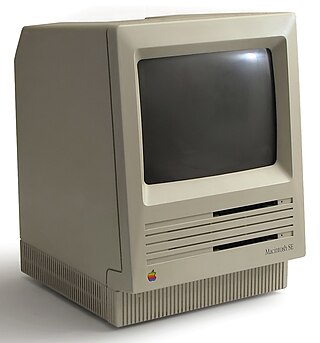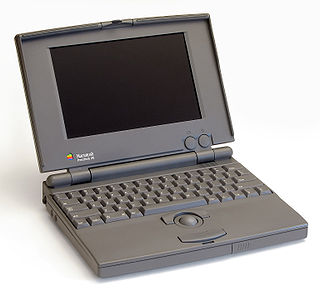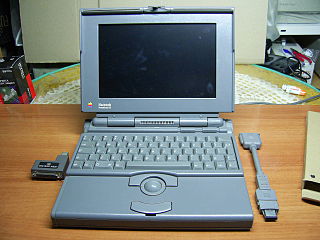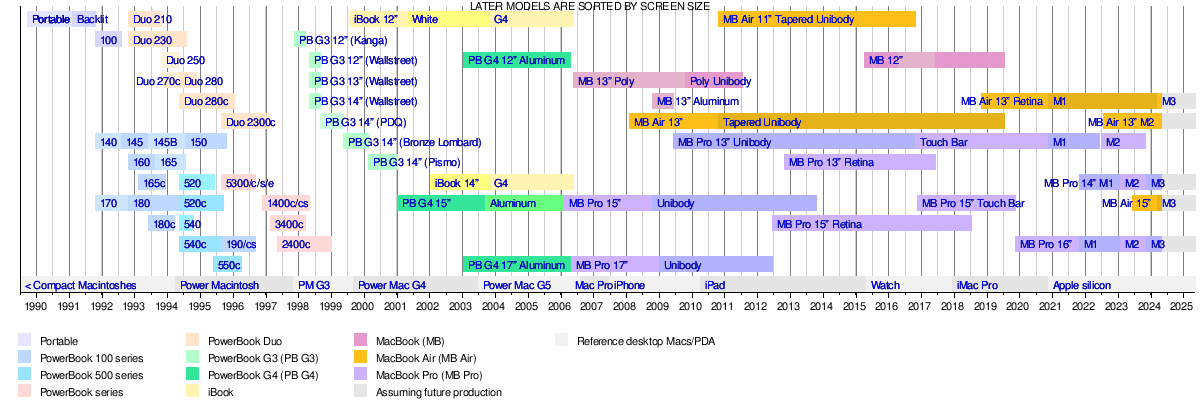
The PowerBook is a family of Macintosh laptop computers designed, manufactured and sold by Apple Computer from 1991 to 2006. During its lifetime, the PowerBook went through several major revisions and redesigns, often being the first to incorporate features that would later become standard in competing laptops. The PowerBook line was targeted at the professional market. In 1999, the line was supplemented by the home and education-focused iBook family.

The Macintosh Plus computer is the third model in the Macintosh line, introduced on January 16, 1986, two years after the original Macintosh and a little more than a year after the Macintosh 512K, with a price tag of US$2,599. As an evolutionary improvement over the 512K, it shipped with 1 MB of RAM standard, expandable to 4 MB, and an external SCSI peripheral bus, among smaller improvements. Originally, the computer's case was the same beige color as the original Macintosh, Pantone 453; however, in 1987, the case color was changed to the long-lived, warm gray "Platinum" color. It is the earliest Macintosh model able to run System Software 5, System 6, and System 7, up to System 7.5.5, but not System 7.5.2.

The Power Macintosh G3 is a series of personal computers designed, manufactured, and sold by Apple Computer from November 1997 to August 1999. It represented Apple's first step towards eliminating redundancy and complexity in the product line by replacing eight Power Macintosh models with three: Desktop and Mini Tower models for professional and home use, and an all-in-one model for education. The introduction of the Desktop and Mini Tower models coincided with Apple starting to sell build-to-order Macs directly from its web site in an online store, which was unusual for the time as Dell was the only major computer manufacturer doing this. Apple's move to build-to-order sales of the Power Macintosh G3 also coincided with the acquisition of Power Computing Corporation, which had been providing telephone sales of Macintosh clones for more than two years.

The Macintosh SE is a personal computer designed, manufactured, and sold by Apple Computer, from March 1987 to October 1990. It marked a significant improvement on the Macintosh Plus design and was introduced by Apple at the same time as the Macintosh II.

The PowerBook G3 is a series of laptop Macintosh personal computers designed, manufactured, and sold by Apple Computer from 1997 to 2001. It was the first laptop to use the PowerPC G3 (PPC740/750) series of microprocessors, and was marketed as the fastest laptop in the world for its entire production run. The PowerBook G3 was succeeded by the PowerBook G4.

The Macintosh Classic II is a personal computer designed and manufactured by Apple Computer, Inc. from October 1991 to September 1993. The system has a compact, appliance design with an integrated 9" monitor, typical of the earliest of the Macintosh range. A carrying handle moulded into the case added a degree of portability at a time when laptops were still relatively uncommon.

The Power Macintosh 6100 is a personal computer designed, manufactured and sold by Apple Computer from March 1994 to March 1996. It is the first computer from Apple to use the new PowerPC processor created by IBM and Motorola. The low-profile ("pizza-box") case was inherited from the Centris/Quadra 610 and 660AV models, and replaced the Macintosh Quadra series that used the Motorola 68040 processor, Apple's previous high-end workstation line.
The Apple Network Server (ANS) was a line of PowerPC-based server computers designed, manufactured and sold by Apple Computer, Inc. from February 1996 to April 1997. It was codenamed "Shiner" and originally consisted of two models, the Network Server 500/132 and the Network Server 700/150, which got a companion model, the Network Server 700/200 with a faster CPU in November 1996.

The Macintosh Quadra 605 is a personal computer designed, manufactured, and sold by Apple Computer from October 1993 to July 1996. The model names reflect a decision made at Apple in 1993 to follow an emerging industry trend of naming product families for their target customers – Quadra for business, LC for education, and Performa for home. Accordingly, the Performa 475 and 476 was sold in department stores and electronics stores such as Circuit City, whereas the Quadra was purchased through an authorized Apple reseller.

The Macintosh Quadra 630 is a personal computer designed, manufactured and sold by Apple Computer from July 1994 to October 1995. It was introduced as the replacement for the Quadra 610, and was the least-expensive computer in the Macintosh lineup with prices starting at $1,199 USD.

The Macintosh Quadra 650, originally sold as the Macintosh Centris 650, is a personal computer designed, manufactured and sold by Apple Computer from February 1993 to September 1994. The Centris 650 was introduced alongside the smaller Centris 610 as the replacement for the Macintosh IIci and Quadra 700, and it was intended as the start of the new midrange Centris line of computers. Later in 1993, Apple decided to follow an emerging industry trend of naming product families for their target customers – Quadra for business, LC for education, and Performa for home – and folded the Centris 650 into the Quadra family.
The Macintosh LC 500 series is a series of personal computers that were a part of Apple Computer's Macintosh LC family of Macintosh computers, designed as a successor to the compact Macintosh family of computers for the mid-1990s mainstream education-market. The all-in-one desktop case is similar to the then recently introduced Macintosh Color Classic, but the LC 500 series is considerably larger and heavier due to its larger screen and a bulging midsection to house the larger electronics, including a 14" CRT display, CD-ROM drive, and stereo speakers.

The PowerBook 100 is a notebook-sized laptop computer designed and manufactured by Sony for Apple Computer and introduced on October 21, 1991, at the COMDEX computer expo in Las Vegas, Nevada. Priced at US$2,500 with external floppy drive, the PowerBook 100 was the low-end model of the first three simultaneously released PowerBooks. Its CPU and overall speed closely resembled those of its predecessor, the Macintosh Portable. It had a Motorola 68000 processor at 16 MHz, 2-8 megabytes (MB) of RAM, a 9-inch (23 cm) monochrome backlit liquid-crystal display (LCD) with 640 × 400 pixel resolution, and the System 7.0.1 operating system. It did not have a built-in floppy disk drive and was noted for its unique compact design that placed a trackball pointing device in front of the keyboard for ease of use.

The PowerBook 180 is a portable computer released by Apple Computer along with the PowerBook 160 in October 1992. At the time, it constituted the new top-of-the-range model, replacing the previous PowerBook 170. Its case design and features are the same as that of the 170, but it shipped with the more powerful 33 MHz Motorola 68030 CPU and Motorola 68882 FPU. Along with the 160, it introduced a new power-saving feature which allowed the processor to run at a slower 16 MHz rate, the same speed as the original 140.

The PowerBook 100 series is a line of laptop PCs produced by Apple Computer.

The Power Macintosh 5500 is a personal computer designed, manufactured, and sold by Apple Computer from February 1997 to March 1998. Like the Power Macintosh 5260 and 5400 that preceded it, the 5500 is an all-in-one design, built around a PowerPC 603ev processor operating at 225, 250 or 275 megahertz (MHz).

The PowerBook 170 was released by Apple Inc. in 1991 along with the PowerBook 100 and the PowerBook 140. Identical in form factor to the 140, it was the high end of the original PowerBook line featuring a faster 25 MHz Motorola 68030 processor with 68882 floating point unit (FPU) and a more expensive and significantly better quality 9.8 in (250 mm) active matrix display. It was replaced by the PowerBook 180 in 1992.

The PowerBook Duo 210 is a portable subnotebook personal computer, manufactured by Apple Computer Inc. and introduced in October 1992. Priced at US$2250, the PowerBook Duo 210 was the low-end model of the two simultaneously released PowerBook Duos. The specifications of the PowerBook Duo 210 are almost identical to the PowerBook 160, except that the PowerBook Duo 210 has a smaller display. Its case design is identical to the PowerBook Duo 230, but it shipped with 25 MHz Motorola 68030, instead of the faster 33 MHz 68030 on the Duo 230. The PowerBook Duo 210 had a 80MB SCSI Hard Disk Drive. It was discontinued on October 21, 1993.

The PowerBook 160 is a portable computer that was released by Apple Computer along with the PowerBook 180 on October 19, 1992 and the PowerBook 165 variants were released the following year. At the time, it constituted the mid-range model replacing the previous PowerBook 140 in processing power. The PowerBook 160 was sold until August 16, 1993.

The PowerBook 150 is a laptop personal computer created by Apple Computer which was introduced on July 13, 1994, and released on July 18, 1994. It was the last member of the PowerBook 100 series to use the original case design, the most affordable of the series when introduced and also the last consumer model.


















